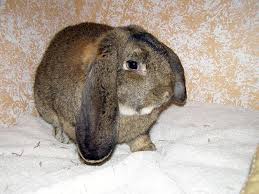
FRENCH LOP - Nikki White (Reguli Cavy & Rabbit Club)

Now very rare in this country, they were imported in the 1990s and there were a few around on the show bench but then they died out. They have been recreated but there are still few of them. They are the the Dwarf Lop writ large, very large, as they are one of the breeds behind it and also the model on which it is based. The one I saw in Canberra, an Agouti, in the late 1990s looked like a boulder with hanging ears. Their size may have been one of the reason they were allowed to die out. I call it "big bunny syndrome". Once the novelty of having or breeding a big rabbits wears off, no one wants to know them as they eat twice as much as other rabbits and need twice as much space, they are heavy to pick up and move and there has always been a preference for little and cute (fuzzy is optional). Hence the preponderance of "mini" this or that especially as pets as they suit apartments and small backyards better
The BRC standard calls for a massive, thickset and firm rabbit with a short broad body, well muscled with little visible neck. The back rises up in a curve to a well muscled rump. It has a broad and deep chest, the legs are short and strong. The head, crown and ears are as for a Dwarf Lop but bigger As with the British and Flemish Giants, there is no maximum weight, only a minimum one of 4.535 kg. Like those other giants, it takes an H ring. Faults include poor muscle tone, long body, poor ear carriage or damaged ears, wrong sort of head or splayed legs. Disqualifications include under maximum weight, malocclusion, and white toenails on coloured rabbits.
HISTORY
This another very old breed, believed to have been created around 1850 in France by a Msr Cordonnier who crossed his Giant Normande with lop-eared rabbits. From France it spread to Germany and the Netherlands, finally being introduced in Britain in 1933. They were not very successful, judges dismissing them as "half lops" because their ears barely touched the ground (they were used to the English Lop with its impossibly long ears trailing across the table). It wasn't until the 1960s that British fancier Meg Brown started importing them, originally to improve her English Lops. She also translated their standard which was accepted by the BRC. This was quite a different rabbit from the English Lop, having a crown, a bold broad head and ears which sat like a horseshoe around its head instead of spreading out on either side of the rabbit.
SO, A FRENCH LOP, THEN?
According to Geoff Russell, they are extremely popular as a pet especially as a house rabbit. They bond really well with humans and thrive on attention. In fact, they crave regular human interaction and can get quite grumpy if they don't get it. They love to play with toys and get up to all sorts of mischief. They also get on with other animals, they are simply not bothered by any animals around them. As a show rabbit, they should be handled frequently from an early age and posed so that they hold their head up. This is done by putting a finger under the chin and stroking the rump gently with the other hand. They should not be shown too young nor too often as youngsters. Four months is best for their first show.
WHAT TO LOOK FOR
Finding one at all could be the real challenge but they should be massive, solid and cobby with fully lopped ears. No 'propeller'-heads (one ear up and one ear down). They should weigh at least 4.5 kg preferably higher.
HOUSING & CARE
As they are a large rabbit they will need a large hutch, around 180 cm long to give them enough exercise space. They should be bedded on a deep layer of shavings with plenty of chopped straw (barley straw if you can get it) or chopped hay on top. Feed is as for other breeds - pellets, mix, fresh fruit and veg, as treats.
FURTHER READING
British Rabbit Council, Standards of Rabbit Breeds 3rd ed. 2011-2016.
Crook, Sandy, Lop Rabbits as Pets. Neptune City, NJ, T.F.H. Publications, 1986
"Lop lore 32: The French Lop" Fur & Feather Oct. 2004 p. 33
Russell, Geoff, A Fancier's Guide to the Lop Rabbit. Ipswich, K.D.S., 2004
Russell, Geoff, Mini Encyclopeda of Rabbit Breeds & Care. Dorking, Interpet Publishing, 2008
Sandford, J.C., The Domestic Rabbit 5th ed. Blackwell, Science, 1996
Verhoef-Verhallen, Esther, Encyclopaedia of Rabbits and Rodents. Lisse, Rebo Productions, 1998
Vriends-Parent, Lucia, The New Rabbit Handbook. Hauppage, NY, Barrons, 1989
Whitman, Bob D., Domestic Rabbits & Their Histories: Breeds of the World. Leawood, KS : Leathers Publishing, 2004
Williams, A.E. Ted, Rabbit Breeding for Perfection. Melbourne, AE Williams, 1992.
ORGANISATIONS
National French and Dwarf Lop Club (UK)